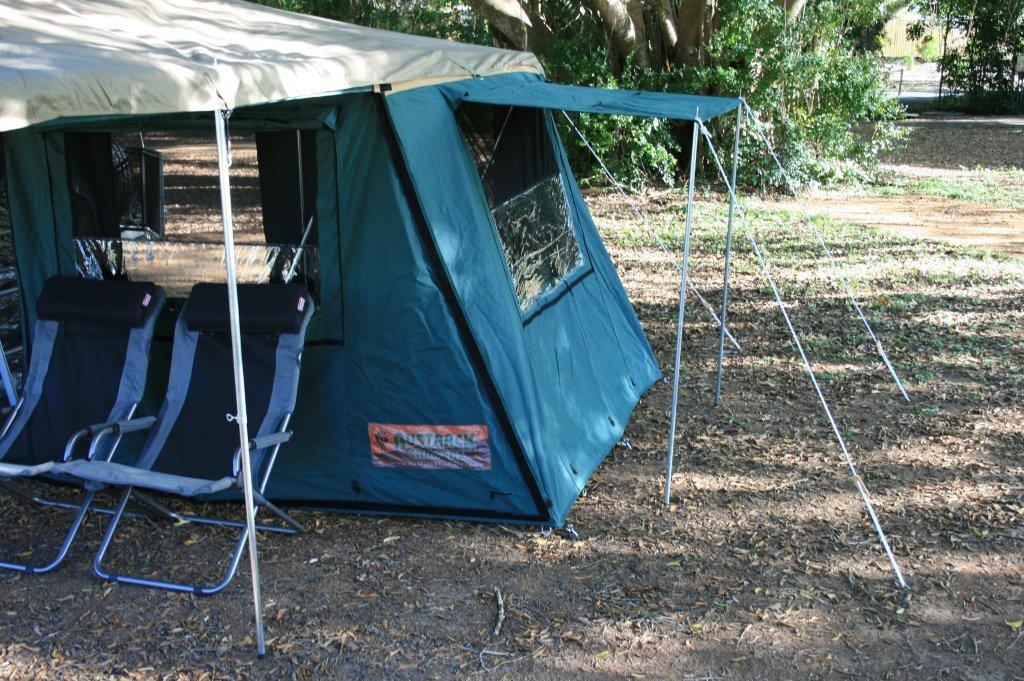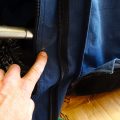Canvas Care

Pre-trip care
In this article we'll look at canvas care - ways you can make your tent last longer.
Before going away on your maiden trip, you will need to ‘weather’ or pre-condition your Camper canvas, in order for your tent to have its own natural water repellence. Set it up in the backyard for a day and night to expose it to the dewy air and possibly a man-made shower from the garden hose to completely soak. The Camper Tent must be wet down thoroughly to allow the fibres to swell and shrink to a tighter weave which closes up the stitching holes which further waterproofs the canvas. If you do not guy rope the sides, the roof may sag and water could collect causing the frame to collapse under the weight. Before wetting down the Camper Tent, zip the door shut. If the front corners of the tent is guyed out too tightly toward the sides, the zipper door may not operate smoothly. Check the tent often to make sure it is not straining or sagging. NEVER PUT A DAMP TENT INTO STORAGE.
Post-trip care
(DO NOT delay in drying your tent when you get home!). When you get back from your trip, set up your tent or trailer again and hose it down. Wash off any dirt, animal droppings, or sap particularly eucalyptus as soon as possible before they degrade the canvas. If damp leaves are left in your canvas when it is packed away, they can start to decompose and possibly stain your canvas. Tent pegs can also leave rust marks if they are wrapped inside a tent or trailer, so use the tent peg bag provided. .
Storage Tips
Ensure the canvas is thoroughly dry before packing away. Most fabrics are susceptible to mildew. Mildew results when canvas is folded when wet, or stored in a damp place.
Never store your camper covered with a tarp (unless it is tied up like a shelter) because it will impede airflow. Mould and mildew thrive on dirt, moisture and decreased airflow. Unavoidable packing up in the rain happens to everyone. The best way of prevention of mould and mildew is to open it up at home as soon as possible, to air dry. Never place canvas in dryers or subject to excessive heat. Air dry only. Never apply heat to fabrics. NO DRYERS.
The user can determine the type of canvas care required. We recommend Spaying all seams once a year with a waterproofing spray available at most camping stores. Always store your tent clean and dry and it will serve you well.
Keep Your Camper Tent Pest Free
It is important to also make sure to give your Camper Tent a thorough vacuuming after every trip, to remove all food and paper nesting material. Ants can find there way into anything.
Canvas Care Tips - Get the most out of your Camper!
Clean the canvas by brushing regularly inside & out, with a soft bristle brush &hosing occasionally with cold clean water.
Avoid dirt, tree sap, leaves, bird droppings, and other debris from accumulating or
remaining in contact with your external cover or canvas.
Never expose canvas to petrol, solvents, kerosene & other similar fluids.
Vegetation could harm the fabric and may cause dry rotting or ugly stains. While
camping, be careful to keep bushes and vines away.
Avoid hairsprays, deodorants or insect sprays on the fabric, as they can impair water repellence and cause staining. If you do washing inside your Camper Tent, small splashes of detergent can effect the waterproofing on the canvas.
Spray canvas with water proofing spray (particularly on seams) available at most camping stores for additional protection of canvas. This should be done annually.
CARE TIPS
Preventative Maintenance
One of the best ways to keep canvas looking good and to delay the need for deep or vigorous cleanings is to hose off on a regular basis (i.e. Monthly if used on long trips), with clean water. This simple method will help prevent dirt from becoming deeply imbedded in the canvas and remove the need for more severe cleanings. In most environments, a thorough cleaning will be needed every two to three years.
Clean Canvas
Do not apply soaps, detergents, cleaning fluids or insecticides. Never use detergents or bleach which could ruin the water repellence and strip the colour of the canvas. Persistent mould or mildew growth should be treated with a purpose made mould & mildew remover. Water should be cold to lukewarm. Never more than 100 degrees. Canvas which has been cleaned extensively may require reproofing with a purpose made reproofing compound available at most camping stores. Use a soft bristle brush to clean.
Mildew
One of the most common problems that occur in canvas is mildew, it is very destructive to cotton fabrics as well as other materials. Mildew usually forms when tents are put into storage when damp, it can start in a very short time particularly if humid. If mildew has started to grow, it can be stopped from spreading by thoroughly drying the tent and treating with a mildew remover, preferably in the hot sun. Always make sure the tent dries completely before putting into storage.




